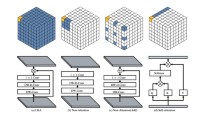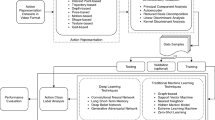Abstract
Graph convolutional networks have achieved remarkable performance in action recognition from skeleton videos. However, most of the existing GCN-based methods improve performance by increasing model parameters, which require a high amount of data. This means that they usually perform poorly on small sample learning tasks. In this paper, we propose a novel enhanced data guidance algorithm to improve the performance of the GCN-based method on small sample datasets. These enhanced data perform coordinate transformation on the skeleton to obtain robustness to scale, rotation and translation. The proposed guidance algorithm allows the target model to learn the advantages of enhanced data and reduce the complexity of the task. We also propose a new key node method, which can select key joints and frames in the spatial and temporal dimensions respectively. This removes the redundant information of the skeleton sequence and significantly reduces the computational cost. Furthermore, the combination of key nodes and enhanced data can greatly reduce the demand for training data. The recognition accuracy rates of 94.81% and 94.19% have been achieved on the public MSR Action3D and UTD-MHAD datasets, respectively. This result proves that our method is significantly better than mainstream 3D action recognition methods.










Similar content being viewed by others
References
Bansal M, Kumar M, Kumar M (2021) 2d object recognition: a comparative analysis of sift, surf and orb feature descriptors. Multimed Tools Appl 80 (12):18839–18857
Berthelot D, Carlini N, Goodfellow I, Oliver A, Papernot N, Raffel C (2019) MixMatch: A holistic approach to Semi-Supervised learning. Curran Associates Inc., Red Hook, NY USA
Cao Z, Simon T, Wei S-E, Sheikh Y (2017) Realtime multi-person 2d pose estimation using part affinity fields. In: 2017 IEEE Conference on computer vision and pattern recognition (CVPR), pp 1302–1310
Chen C, Jafari R, Kehtarnavaz N (2015) Improving human action recognition using fusion of depth camera and inertial sensors. IEEE Transactions on Human-Machine Systems 45(1):51–61
Chen C, Jafari R, Kehtarnavaz N (2015) Utd-mhad: A multimodal dataset for human action recognition utilizing a depth camera and a wearable inertial sensor. In: 2015 IEEE International conference on image processing (ICIP), pp 168–172
Cui R, Hua G, Zhu A, Wu J, Liu H (2019) Hard sample mining and learning for skeleton-based human action recognition and identification. IEEE Access 7:8245–8257
Defferrard M, Bresson X, Vandergheynst P (2017) Convolutional neural networks on graphs with fast localized spectral filtering
Du Y, Wang W, Wang L (2015) Hierarchical recurrent neural network for skeleton based action recognition. In: 2015 IEEE Conference on computer vision and pattern recognition (CVPR), pp 1110–1118
Gupta S, Kumar M, Garg A (2019) Improved object recognition results using sift and orb feature detector. Multimed Tools Appl 78(23):34157–34171
Hou Y, Li Z, Wang P, Li W (2018) Skeleton optical spectra-based action recognition using convolutional neural networks. IEEE Transactions on Circuits and Systems for Video Technology 28(3):807–811
Hussein M, Torki M, Gowayyed M, El Saban M (2013) Human action recognition using a temporal hierarchy of covariance descriptors on 3d joint locations, 08
Joan B., Zaremba W, Szlam A, LeCun Y (2014) Spectral networks and locally connected networks on graphs
Kipf TN, Welling M (2017) Semi-supervised classification with graph convolutional networks
Kumar M, Chhabra P, Garg NK (2018) An efficient content based image retrieval system using bayesnet and k-nn. Multimedia Tools Appl 77 (16):21557–21570
Lee D-H (2013) Pseudo-label: The simple and efficient semi-supervised learning method for deep neural networks. In: ICML 2013 Workshop: Challenges in Representation Learning (WREPL), p 07
Lee H, Hwang SJ, Shin J (2020) Self-supervised label augmentation via input transformations
Lee I, Kim D, Kang S, Lee S (2017) Ensemble deep learning for skeleton-based action recognition using temporal sliding LSTM networks. In: IEEE International conference on computer vision, ICCV 2017, Venice, Italy, october 22-29, 2017. IEEE Computer Society, pp 1012–1020
Li Y, Hu H, Zhou G (2019) Using data augmentation in continuous authentication on smartphones. IEEE Internet Things J. 6(1):628–640
Li W, Zhang Z, Liu Z (2010) Action recognition based on a bag of 3d points. In: 2010 IEEE Computer society conference on computer vision and pattern recognition - workshops, pp 9–14
Liu J, Shahroudy A, Xu D, Wang G (2016) Spatio-temporal lstm with trust gates for 3d human action recognition. 9907, 10
Niepert M, Ahmed M, Kutzkov K (2016) Learning convolutional neural networks for graphs
Shi L, Zhang Y, Cheng J, Lu H (2019) Two-stream adaptive graph convolutional networks for skeleton-based action recognition. In: 2019 IEEE/CVF Conference on computer vision and pattern recognition (CVPR), pp 12018–12027
Shuman DI, Narang SK, Frossard P, Ortega A, Vandergheynst P (2013) The emerging field of signal processing on graphs: Extending high-dimensional data analysis to networks and other irregular domains. IEEE Signal Proc Mag 30(3):83–98
Si C, Chen W, Wang W, Wang L, Tan T (2019) An attention enhanced graph convolutional lstm network for skeleton-based action recognition. In: 2019 IEEE/CVF Conference on computer vision and pattern recognition (CVPR), pp 1227–1236
Simonyan K, Zisserman A (2014) Two-stream convolutional networks for action recognition in videos
Sohn K, Berthelot D, Li C-L, Zhang Z, Carlini N, Cubuk ED, Kurakin A, Zhang H, Raffel C (2020) Fixmatch: Simplifying semi-supervised learning with consistency and confidence
Thakkar K, Narayanan PJ (2018) Part-based graph convolutional network for action recognition
Tian D, Lu ZM, Chen X, Ma LH (2020) An attentional spatial temporal graph convolutional network with co-occurrence feature learning for action recognition. Multimed Tools Appl, 79(2)
Vemulapalli R, Arrate F, Chellappa R (2014) Human action recognition by representing 3d skeletons as points in a lie group. In: 2014 IEEE Conference on computer vision and pattern recognition, pp 588–595
Wang L, Huynh DQ, Koniusz P (2020) A comparative review of recent kinect-based action recognition algorithms. IEEE Trans Image Process 29:15–28
Wang P, Li W, Li C, Hou Y (2018) Action recognition based on joint trajectory maps with convolutional neural networks. Knowl-Based Syst 158:43–53
Wang X, Qi C (2020) Detecting action-relevant regions for action recognition using a three-stage saliency detection technique. Multimed Tools Appl 79 (11):7413–7433
Wei P, Sun H, Zheng N (2019) Learning composite latent structures for 3d human action representation and recognition. IEEE Trans Multimed 21 (9):2195–2208
Xie Q, Dai Z, Hovy E, Luong M-T, Le QV (2020) Unsupervised data augmentation for consistency training
Yan S, Xiong Y, Lin D (2018) Spatial temporal graph convolutional networks for skeleton-based action recognition. 01
Zhang Z (2012) Microsoft kinect sensor and its effect. IEEE MultiMedia 19(2):4–10
Zhou L, Li W, Zhang Y, Ogunbona P, Nguyen DT, Zhang H (2014) Discriminative key pose extraction using extended lc-ksvd for action recognition. In: 2014 International conference on digital image computing: Techniques and applications (DICTA), pp 1–8
Author information
Authors and Affiliations
Corresponding author
Additional information
Publisher’s note
Springer Nature remains neutral with regard to jurisdictional claims in published maps and institutional affiliations.
Rights and permissions
About this article
Cite this article
Zhang, C., Liang, J., Li, X. et al. Human action recognition based on enhanced data guidance and key node spatial temporal graph convolution. Multimed Tools Appl 81, 8349–8366 (2022). https://doi.org/10.1007/s11042-022-11947-8
Received:
Revised:
Accepted:
Published:
Issue Date:
DOI: https://doi.org/10.1007/s11042-022-11947-8




